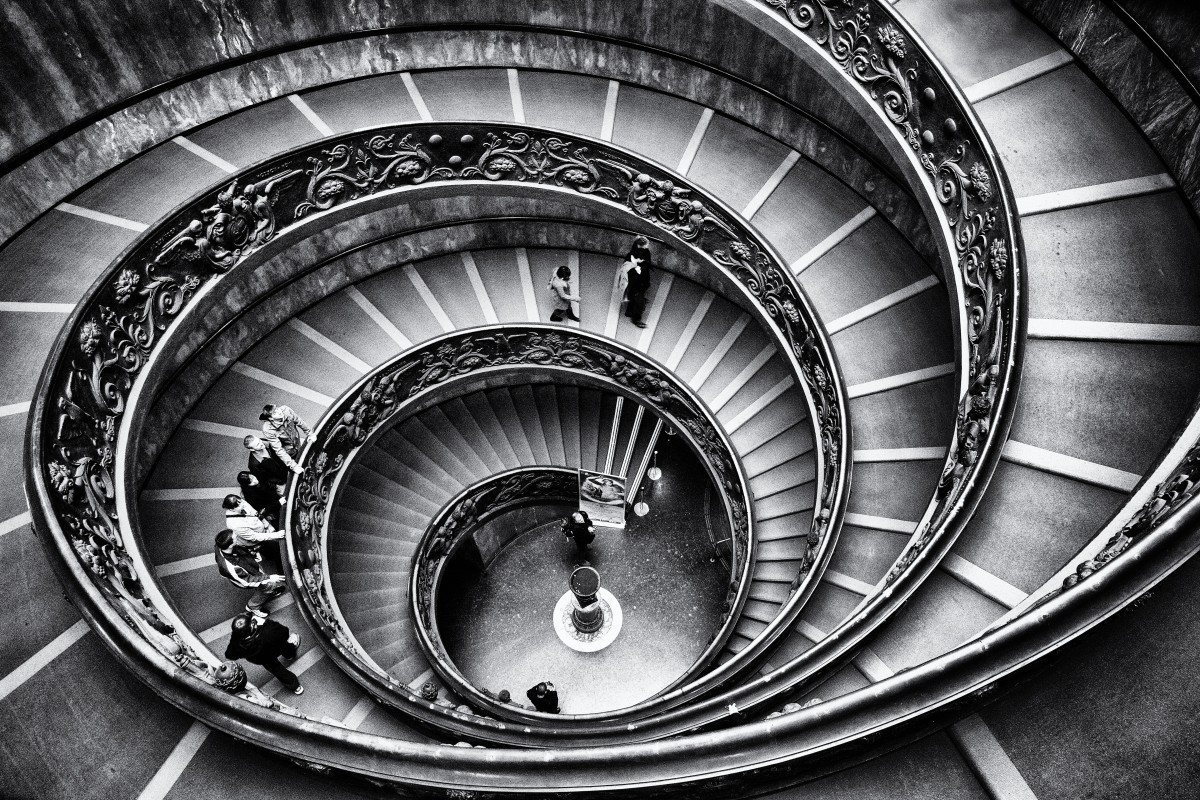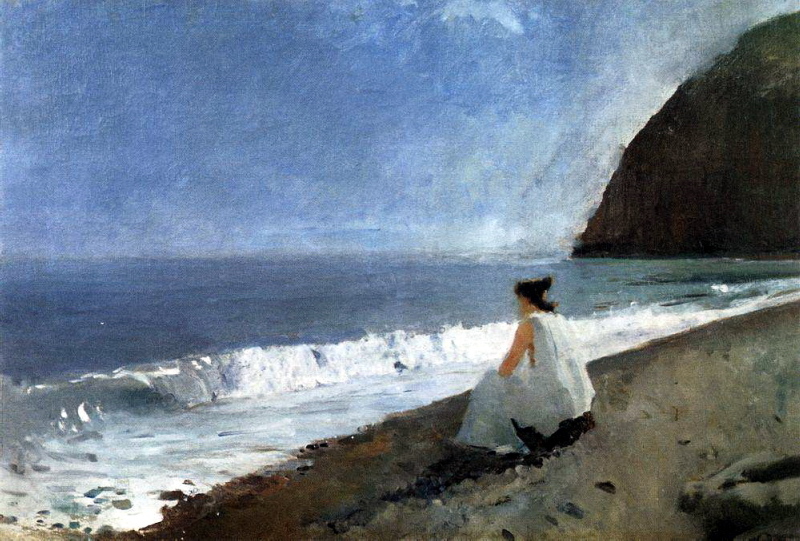
Spiral staircase, the Vatican
Imagine a young woman from a provincial town in England who has just married an elderly clergyman. They have been on their honeymoon in Rome for six weeks. It is the young woman’s first time in Europe, and after a lifetime of molding herself and her ideas of religion to an austere English Puritanism, with limited access to history books and almost no experience of art, she arrives in Rome and cannot make sense of its pomp or scale. She also cannot make sense of her husband, who often leaves her behind to conduct research in the Vatican Library. So, in chapter 20 of the Victorian realist novel Middlemarch (1871–1872), we find her crying alone in her room.
This woman, Dorothea, is a well-meaning and kind-hearted heroine. She marries the clergyman and scholar Edward Casaubon because she is in awe of his lifetime of research on a “Key to All Mythologies,” a religious history and comparative study of mythological origins. As her natural bent is philanthropic, she naively stylizes Casaubon as another Milton or Locke, without thinking about the realities of relationships and marriage. For her, with her vague notions of history, Milton and Locke are towering, majestic figures who have benefited humankind through their contributions to poetry and philosophy. She imagines before her wedding that assisting Casaubon in what she thinks of as his noble enterprise will fulfill her longing to bring what is good and beautiful to others, but she has difficulty appreciating the complex and nuanced range of emotional needs Casaubon must also have. Like her knowledge of the wider world, her ideas about married life and her husband are very limited.
Unknown to Dorothea, Casaubon in fact shrinks from any hint of criticism. He keeps his research close and is frequently offended by Dorothea’s offers to help him prepare his manuscripts for publication. He knows, even if he cannot freely admit it to himself, that he is unable to complete his project successfully because he is prejudiced against German scholarship. In Europe in the early-to-mid–nineteenth century—when this story is set—German resources on religion and mythology are recognized as the most advanced of the era, but German scholars have also inaugurated “higher criticism,” or the application of the historical-critical method to the Bible, and Casaubon stubbornly resists any non-theologically based study. He denies his limited perspective to himself and hides the complex range of his insecurities and self-doubts from his wife. Over time, she begins to feel shut away from both her husband and her cherished altruistic aspirations. Husband and wife become hedged in and separated by their individual partialities and preconceptions.
Both Dorothea and Casaubon are depicted as tragic figures, albeit in different ways: Casaubon because he is unable to cope with the scholarly advancements of his age and humbly confide in his wife, and Dorothea because she is too sheltered and idealistic to understand how to navigate her confused emotions about herself, her husband, marriage, and the world beyond her rural upbringing. Their tragedies should touch us keenly because they are not grandiose or romantic; they deal with the regular, day-to-day challenges we all potentially face in how we learn new things and communicate with ourselves and others.
The process of learning—gathering knowledge and acquiring certain skills, attitudes, and habits—shapes our personalities and in turn informs our treatment of others. This process is inextricably tied up with morality and the ethical nature of our behavior. In human experience, acquiring knowledge happens both consciously and unconsciously, and the result is always partial and limited. We each carry a unique set of preferences and prejudices with us wherever we go, which plays a part in our decisions. How, then, can we learn to become appropriately self- and other-aware as well as adequately cognizant about the world in which we live? How do we navigate the relationship that exists between knowledge, ourselves, goodness, and action? How, in short, do we avoid becoming enmired by our deficiencies, as did Dorothea and Casaubon? When the novelist George Eliot (pseudonym of Mary Ann Evans, 1819–1880) was writing, a new idea that had just come to Britain from Germany via one of her favorite writers helped her traverse this territory: many-sidedness.

Iphigenia in Tauris, 1893, Valentin Serov
The term many-sidedness entered English in the 1830s as a translation of the German word Vielseitigkeit, predominantly used in Germany to describe the multifaceted mind and objectivity of the literary figure and Sage of Weimar, Johann Wolfgang von Goethe (1749–1832). Goethe, in many ways, is to Germany what Shakespeare is to England. He was an incredibly prolific and influential writer, composing innovative poetry and novels (we have him to thank for the Bildungsroman, or novel of education), biographies, scientific treatises, and dramas. Based in Weimar, he was an administrator and civil servant, a scientist, geologist, botanist, actor, and philosopher. He was considered a master of character sketches and observations about the natural world and had—as one of his friends described—a habit of “transform[ing] himself in imagination into the very thing [he examined] itself.”1 Well-known in Germany for his immense versatility, Goethe was reputed to have attempted some form of achievement in almost every field of thought, and when we look at his worldview, it is easy to see why he expended his energy in so many directions. He regarded the world holistically, believing that every piece or type of knowledge is part of a larger whole.
Practicing many-sidedness means practicing a kind of many-mindedness, moving between multiple points of view and seeing how far you can go in entering into the feelings and experiences of those who are very different from you.
This holistic approach meant that no subject was out of bounds. His commitment to holistic thinking motivated his curiosity and humility, his refrain from passing judgment, his desire for objectivity, and his respectful acceptance of difference among classes, cultures, languages, and religions. Goethe made connections wherever he went. In one story, while out walking near Venice, he came across the skull of a ram and immediately fell upon it to decipher some problem he had been considering in comparative anatomy. His holistic thinking also influenced his treatment of others. While hearing the scientist Franz Joseph Gall (1758–1828) describe his new theory of phrenology (the idea that the shape and size of your head can be measured to predict your mental traits), instead of being contemptuous and prejudiced against the speaker and his ideas, as were many of his contemporaries, Goethe was full of questions about the man’s methods and wanted to connect them with his own observations about dissection and psychology.2 Goethe’s aptitude for many-sidedness and for seeking out beneficial connections rather than harping on disagreements became his trademark, and he pleasantly and humorously embraced it, even acknowledging it in his collection of Maxims and Reflections (1833) with a jovial call: “Let us be many-sided! Turnips are good, but they are best mixed with chestnuts. And these two noble products of the earth grow far apart.”3

Johann Wolfgang von Goethe
Goethe’s practice of many-sidedness also heralded sympathetic treatment and acknowledgment of others, or what we would term empathy. Practicing many-sidedness means practicing a kind of many-mindedness, moving between multiple points of view and seeing how far you can go in entering into the feelings and experiences of those who are very different from you. In this respect, Goethe’s many-sidedness is perhaps best illustrated by his keen interest in non-Christian religions and different languages—particularly Islam and Arabic—which led to his composition of the West–Östlicher Divan (1814–1836), or West-Eastern Diwan. This massive collection of lyrical poems took decades to complete and was inspired by the Persian poet Hafez (1315–1390) as well as various Qur’anic āyāt. Goethe used to read translations of the Qur’an out loud to the Weimar elite, and he asked Oriental scholars to help him with Arabic when he found translations in German and French too confining. Although still imperfect in his understanding of Islam due to the limitations of the scholarship around him, Goethe ambitiously planned a drama, Mahomet, about the Prophet of Islam’s life. Here, Goethe’s many-sidedness shows less in his advanced learning and more in his decision to stay away from the stereotypical hallmarks of the European understandings of Islam that we find in, say, Voltaire’s Mahomet (1736), a portrait of the Prophet as an imposter. Goethe never completed his drama, but it did result in his famous poem-hymn “Mahomets Gesang” (1777), or “Song of Mahomet.” Goethe’s careful attention to and sympathetic appreciation of different viewpoints (even a perspective as maligned in Europe as Islam) inspired a generation of avant-garde thinkers. It provided, for example, a scholarly prototype of many-sidedness—as the practice of impartiality, tolerance, empathy, and respect—that helped lay the foundations for comparative religion as we know it.
All things considered, Goethe’s practice of many-sidedness made him eccentric in his day (as a middle-aged man, he even left his administrative post in Weimar without telling anyone and went to Italy for two years to learn about art), and the model he hands down entails continually developing your powers of outward observation and inward reflection, without regard for popular modes of thought or action. It also suggests that our opinions, no matter how sensible, should never calcify or fossilize; they should remain living and breathing through further observation, research, discussion, and friendly debate. In this way, we learn to exercise our imaginations in the service of others and—throughout it all—to keep up a (humble) willingness to correct our errors. Perhaps the best way to remember these things and to draw them into our daily lives and ways of thinking is to recognize that many-sidedness teaches a universal truth while addressing a universal human experience: knowledge is holistic, with “many sides”—some seen, some unseen—and it is the human condition to be limited in our perception of the whole. This philosophical foundation of many-sidedness fired the imagination of George Eliot, and, believing that these admissions carried their own special wisdom, she set to work.
As a newly minted word in Britain, many-sidedness came to imply intellectual development on all sides, wide-ranging sympathy and tolerance, earnest conduct, and a level of self-awareness that stimulated and worked in unison with other-awareness. It signified a humanist ideal of self-cultivation and open-mindedness, and George Eliot did her best to harness this in her fiction and to promote many-sidedness as an intellectual and moral ideal for her readers. Because Eliot began her writing career as a translator of German texts, she knew a lot more about Goethe and his works than did the average British reader. German literature was not very popular in Britain during Eliot’s lifetime—partly because it was difficult to translate into English and partly because it was associated too closely with “higher” biblical criticism (Casaubon’s prejudice against German scholarship was something the average British reader shared)—so Eliot had her work cut out for her. She started by writing articles that advocated German literature in general and Goethe and his versatility and sympathy in particular, but she also found that using many-sidedness as a method or technique in her fiction was an effective way to advocate its intellectual practicality and moral necessity.